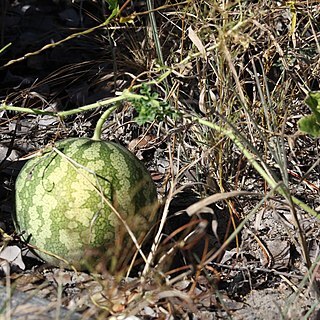Monoecious prostrate perennial with woody rootstock. Stems several to many fairly slender to stout, canescent, not much branched, in the young parts puberulous to shortly hispid, later glabrous, usually scabrid, up to at least 2 m long. Leaves rigid and fragile, ovate to broadly suborbicular in outline, with strongly recurved margins, canescent, usually glabrous, rather smooth above, except on the shortly setose-hispid main nerves, at first shortly setose-scabrid, later callous-scabrid and white-punctate mainly near the margins below, 2-6 cm in diam., 3-5-fid nearly to the base; segments strongly lobulate, more or less rounded at the apex, crisped along the margin; petioles fairly stout, greyish, shortly and densely setose, 0.5-2 cm long. Tendrils 0. Male flowers: pedicel finely setose-hispid to glabrous, 0.5-3 cm long; receptacle shortly and rather sparsely setose-hispid, 5-6 mm long; sepals shortly setose, erect, narrowly triangular, 1.5-3.5 mm long; petals yellow, obovate, rather densely and shortly pubescent outside, 7-10 mm long. Female flowers: peduncles rather stout, 1-3 cm long; ovary narrowly ovoid or ellipsoid, shortly and thinly pubescent, 15-25 mm long. Fruit subglobose, green mottled with lighter green turning concolorous, yellow, glabrous, 8-15 cm in diam., with whitish very bitter pulp. Seeds black or brown, ovate in outline compressed, 8 mm long.
More
Monoecious, scabrid-hairy, perennial herb, with woody rootstock and prostrate stems, up to more than 2 m long, without tendrils. Leaves ± cordate, up to 95 mm long, deeply dissected, crinkled. Male and female flowers solitary in leaf axils, 7-10 mm long, yellow. Fruit subglobose, 80-150 mm diam., glabrous, mottled green, maturing yellow. Whole plant very bitter and poisonous, except edible and nutritious seeds.
A pumpkin family herb. It lies along the ground. It has a woody taproot and keeps growing from year to year. New shoots develop after rain. They can be 2 m long. It does not have tendrils. The leaves when crushed have the smell of peanut butter. The flowers are yellow. Both male and female flowers are on the same plant but separate. The fruit are pale green with dark streaks. The fruit are 8-18 cm across.
The fruit are used for juice and also in porridge. The young fruit are boiled and the water changed to remove the bitterness. The fruit are also buried under the fire at night and the liquid drunk when they are dug up next morning. The seeds yield oil. The seeds are also roasted and crushed then eaten.

